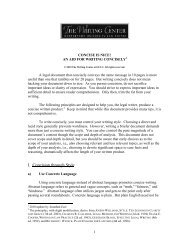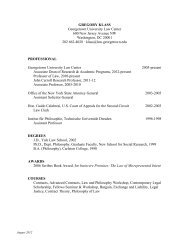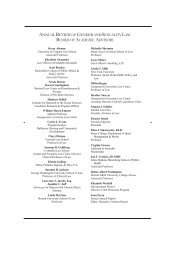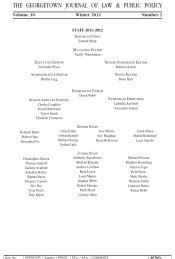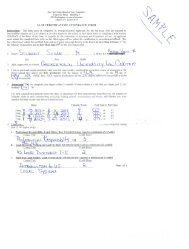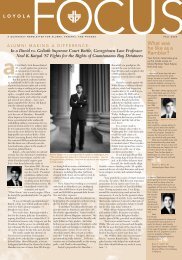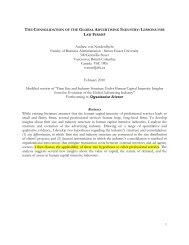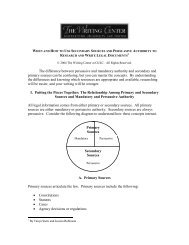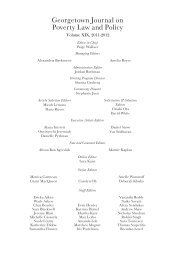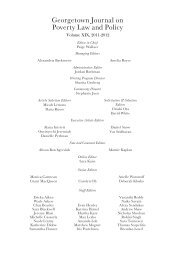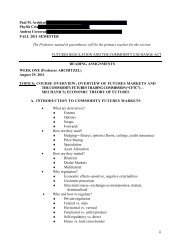Date: April 12, 2013 Topic: The Shrinking ... - Georgetown Law
Date: April 12, 2013 Topic: The Shrinking ... - Georgetown Law
Date: April 12, 2013 Topic: The Shrinking ... - Georgetown Law
Create successful ePaper yourself
Turn your PDF publications into a flip-book with our unique Google optimized e-Paper software.
Independent variables<br />
Technology use (document download): In models predicting new tie formation, we coded<br />
technology use at the dyad level, based on whether a given M had downloaded a given P’s<br />
document. For this variable, downloading was coded 1, and otherwise the variable was coded 0.<br />
In order to use include technology use in our models predicting value creation, we aggregated<br />
document download activity at the dyad level to create a variable which is the count of P’s from<br />
whom each M had downloaded documents. This count variable ranged across individual M’s and<br />
years from 0 to 49.<br />
Indirect ties: Indirect ties exist between an M and a P if there is a “two step” connection<br />
between them, but no direct tie. We are able to observe indirect two-step ties in our cross-nested<br />
data because individual managers work on client projects for multiple partners. Hence M1 has an<br />
indirect tie to P2 if there is a proximal M2 who works on projects for the same P1 as he does,<br />
who also works on projects for P2. In this case, although M1 is not directly working for P2,<br />
information could flow between them through proximal colleague M2. We considered direct and<br />
indirect ties to be mutually exclusive; hence if there was a direct tie between an M and a P (i.e.<br />
M did not bill any of P’s clients), we did not consider that as an indirect tie.<br />
Direct ties. We operationalize direct ties based on a prior connection between M and P.<br />
Analytic approach<br />
New tie formation: To analyze new tie formation, we conducted a dyad-level analysis,<br />
using a risk of all possible dyads between the managers and partners across all possible years of<br />
data. Thus the unit of analysis was the dyad-year. We employed multilevel logistic regression<br />
models, using STATA’s xtmelogit command, to predict the formation of a new tie in a given<br />
year. <strong>The</strong>se models include two-way crossed random effects to account for unmeasured variance<br />
associated with both individual managers and individual partners. <strong>The</strong> two way crossed effects<br />
design (also sometimes referred to as cross-nesting) is appropriate given that managers are often<br />
nested within more than one partner’s projects, meaning that although the data are multilevel,<br />
traditional approaches that assume full nesting of lower level units within higher level units<br />
would be in appropriate. A common analogy for this type of data structure is raters and subjects,<br />
where each rater evaluates multiple subjects, and each subject is also evaluated by multiple raters.<br />
<strong>The</strong> final models included 8326 dyad-years.<br />
Value creation. For our value creation analysis, we shifted to the individual level. We<br />
used person-year data to predict yearly value creation outcomes for M’s. We employed OLS<br />
regression models with individual fixed effects, using STATA’s xtreg command. <strong>The</strong> final<br />
models included 253 person-years. In all value creation and new tie formation models, the<br />
independent variables are lagged one year. Year dummies are also included in all models to<br />
control for unobserved variation associated with changes taking place over time in the case firm.<br />
Because of our fixed and random effects model designs, we did not include other controls for<br />
individual differences in our analyses.<br />
RESULTS<br />
Descriptive statistics are presented in Table 2. <strong>The</strong> left-hand column of Table 2 provides<br />
information related to the dyad-year sample, and the right-hand column provides information<br />
related to the person-year sample. Table 3 presents the results for models predicting new tie<br />
formation, and Table 4 presents the result for models predicting value creation.<br />
<br />
8



